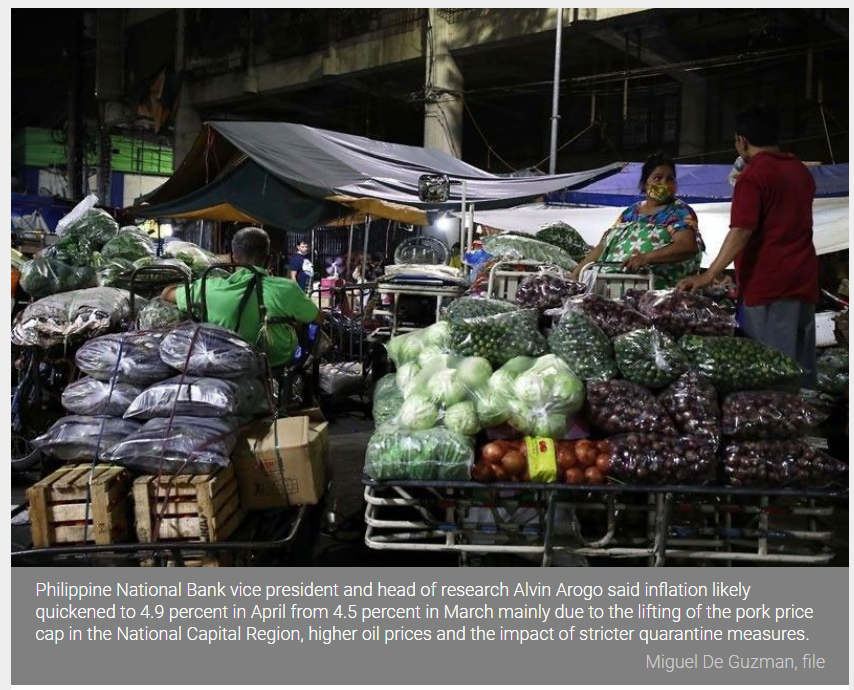Philippines: Economists see pickup in inflation
MANILA, Philippines — Inflation likely accelerated in April due to the increase in the prices of oil and food products, economists said.
Philippine National Bank vice president and head of research Alvin Arogo said inflation likely quickened to 4.9 percent in April from 4.5 percent in March mainly due to the lifting of the pork price cap in the National Capital Region (NCR), higher oil prices and the impact of stricter quarantine measures.
According to the Philippine Statistics Authority (PSA), the price of lean pork in the NCR increased by eight percent to P355 per kilo last month.
Arogo also attributed the faster increase in inflation to the 29 percent quarter-on-quarter increase in Dubai crude oil price to $64.4 per barrel as well as the reduction in transportation capacity in the NCR and nearby provinces or NCR Plus.
“Meanwhile, downside risk can come from lower prices of fish and vegetables in NCR,” Arogo said.
Inflation averaged 4.5 percent in the first quarter, exceeding the two to four percent target set by the Bangko Sentral ng Pilipinas (BSP).
Emilio Neri Jr., lead economist of Ayala-led Bank of the Philippine Islands, said inflation likely accelerated to 4.9 percent due to higher prices of meat, fish and rice as well as more expensive power rates.
However, Neri said the impact of the current enhanced community quarantine and modified enhanced community quarantine in the NCR Plus is not as disruptive as that in July last year as the delivery of basic goods appeared to have moved freely this time compared to prior restrictions.
ING Bank Manila senior economist Nicholas Mapa said inflation last month may have settled at 4.7 percent due largely to base effects and a sustained acceleration in transport costs.
Mapa said food prices remained elevated but continued to soften modestly as slowing inflation for fruits and vegetables offsets stubbornly high meat costs.
He said utility prices dipped only to be offset by accelerating transport costs tagged to transport fares and retail pump prices.
“Lastly, other services are expected to exert upward pressure on headline inflation while inflation for recreation and cultural activities will by all indications remain in deflation,” Mapa said.
According to Mapa, demand-pull factors remain relatively absent and this is to be expected amid the pandemic-induced recession.
“We do believe that the probability that inflation would breach the five percent handle has diminished somewhat with inflation likely decelerating in one to two months. If this happens, I do believe the April print to be peak for the year, barring any unforeseen cost push factors,” Mapa said.
Security Bank chief economist Robert Dan Roces also believes inflation accelerated to 4.7 percent in April but could still pick up further and average five percent this year.
Roces said Executive Order 128, which reduces tariffs on pork imports, would rein-in cost inflation emanating from heavily weighted food basket, while the reimposition of stricter lockdown in NCR Plus for most of the second quarter slowed price growth in other indices.
“A low base from 2020 will keep readings above four percent, and we are still factoring in some inflationary risks from spikes in international oil prices when production is revived as global demand returns,” Roces said.
UnionBank chief economist Ruben Carlo Asuncion said inflation likely rose to 4.6 percent last month as pork prices remained elevated and would continue to be a huge contributor to consumer price index (CPI) food’s upward pressure on headline.
“All other components of CPI may be on the downward direction except for transport and electricity for non-food. Overall, we see a slight uptick for headline inflation this April and see May as the start of its decline with the influx of imported pork products to help ease supply constraints and prices,” Asuncion said.
Source: https://www.philstar.com/business/2021/05/02/2095170/economists-see-pickup-inflation


 English
English




